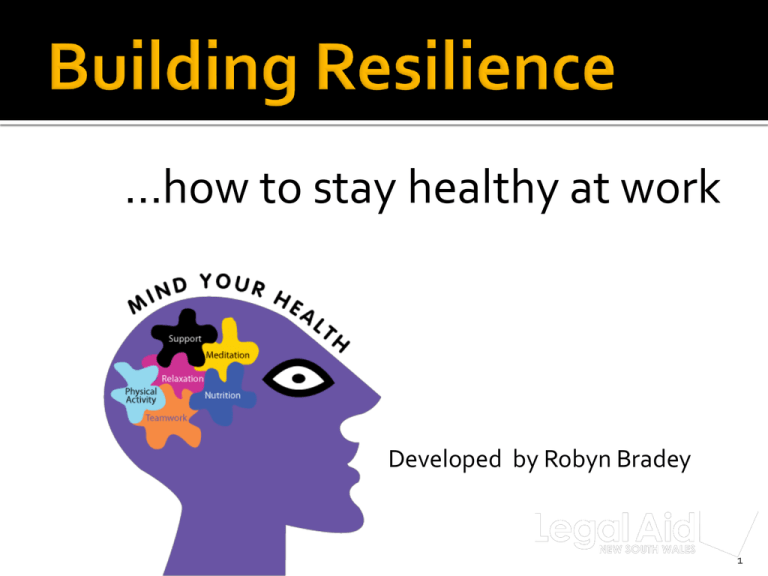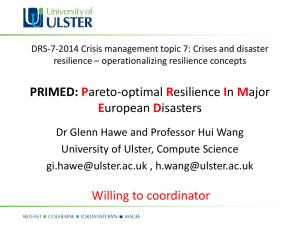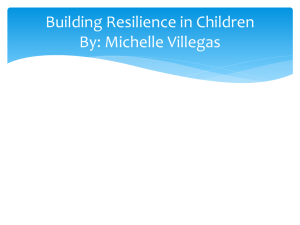Resilience
advertisement

…how to stay healthy at work Developed by Robyn Bradey 1 Stress activates our fear centre This turns down our immune system Operates from our right emotional brain Sidelines our executive function And triggers fight or flight Building Resilience – Robyn Bradey - August 2012 2 But their stress response only lasts about 3 minutes, which is the time it takes to run away from a lion! Once the lion catches a fellow zebra or they escape, the zebras stress response is quickly turned off. Turning the immune system and soothing mechanisms back on. Building Resilience – Robyn Bradey - August 2012 3 The fear response can stay on for hours, days, weeks, months or even years because we ruminate. We analyse what went wrong Go over and over it in our minds And worry about what will happen next. Building Resilience – Robyn Bradey - August 2012 4 This effectively means we keep retraumatising ourselves by our thoughts and worries long after the event and even before it!! All this time our immune system is compromised, and trauma chemicals are chugging around our brains and bodies. From Robert Sapolsky, 1994 Building Resilience – Robyn Bradey - August 2012 5 Sickness Fatigue Sleep disturbance Weight loss or gain Generalised anxiety Poor decision making Relationship issues Building Resilience – Robyn Bradey - August 2012 6 Memory problems Over reactions Avoidance Loss of empathy and intuition Increased stressful situations arising from poor judgement Cynicism Building Resilience – Robyn Bradey -– August 2012 7 A feeling of futility Disparaging workmates, clients and others Blame and shame Loss of confidence. Building Resilience – Robyn Bradey -– August 2012 8 Chapter 2 When You Smile, The World Smiles With You No Laughing Matter In 1962 in Tanzania an epidemic of laughing spread through many villages resulting in the closing of several schools This was a “mass psychogenic illness” – also known as “epidemic hysteria” and was traced to three teenage girls Photo by Casey Lehman Photo by Federia Olivieri Photo by k-girl, Flikr No Laughing Matter “Emotional Stampedes” are common. Did you ever feel sick after a friend complained of a stomach ache from the dinner you both ate? Photo by Angelo Juan Ramos Photo from Nokes, Flikr The Importance of Emotions Emotions coordinate group activity by: • Communicating information • Facilitating interpersonal bonds • Synchronizing behavior • Preceded language as a form of communication Photo by Rebeka Ireland Example: mother-infant pair bonding Stop Mimicking Me! Emotional Contagion spreads for two reasons: 1. We are biologically hardwired to outwardly mimic others 2. We benefit from adopting the inward state of others Facial Feedback Theory: people imitate others’ facial expressions and come to feel as they do (the path of signals is from the muscles of the face to the brain) Mirror Neuron: one system in the human brain possibly responsible for the “catching of emotions” Photo by Jennifer Morton Emotional Contagion • Most prevalent in networks with high transitivity • Physical Proximity and face-to-face interactions are important (Facial Feedback Theory) • Women are affected in MPI epidemics more often • more inclined to discuss symptoms • better sense of smell (smell and emotion are both regulated by the orbitofrontal cortex of the brain) Photos by Gontzal Garcia del Cano and Diego Cupolo Family Feelings Experiment using beepers to record and track the emotional states of family members • The strongest path was from daughters to parents • Parents had little affect on daughters • Fathers had a significant affect on wives and sons Photos by Mike Carroll and Squiddles, Flikr What this means…when a father returns grumpy from work the whole household soon becomes miserable If You Wanna Be Happy Our friends and their friends and their friends affect our happiness! (Three Degrees of Influence Rule) • Happy and unhappy people cluster among themselves • Unhappy people are on periphery of the network Photo by Annika Bischof If You Wanna Be Happy • A person is 15% more likely to be happy if directly connected to a happy person (1 degree) • At 2 degrees 10% more likely to be happy • At 3 degrees 6% more likely to be happy • Each unhappy friend deceases the likelihood of happiness 7% If You Wanna Be Happy An increase of $10,000 of income per year yields only a 2% increase chance in happiness. Compare that to a 15% chance from a happy friend and a 6-10% from someone you may have never met, but to whom you are indirectly tied! Photo by Andy Perkins Photo by Minoria Hinds Happiness, It’s in the Genes We have a “set point” for personal happiness strongly influenced by our genes Long term happiness is affected by: • 50% genes • 10% circumstance (i.e. quality of life) • 40% attitude (what you think and do) Photo by Duncan Hull Photo by Emily Faulk Alone in the Crowd Loneliness is a discrepancy between desire for connection and actual connections--spreads according to the three degrees rule Photo by Tom Woodward Each extra friend reduces the frequency of loneliness by 2 days per year (the average person feels lonely 48 days per year) Loss aversion Emotion before reason First impressions to classify Gossip Confidence before realism Empathy and mind reading Contest & display Community Hierarchy & status Source: Andrew O’Keefe, 2011, Hardwired Humans Building Resilience – Robyn Bradey -– August 2012 22 ….. leading to the importance of the first 7 words which must be: Specific Plain Truthful Single concept Emotional Without jargon Contain the future narrative Building Resilience – Robyn Bradey - August 2012 23 ... a set of interpersonal relationships structured to achieve established goals. .... a group of people ... with a common purpose (which is understood by all members) who play assigned roles... using their individual skills and talents to best advantage ... to accentuate the strengths and minimise the weaknesses, and achieve the common goal. Shields, In the Tiger’s Mouth Does this definition fit your workplace? Building Resilience – Robyn Bradey - Legal Aid NSW – August 2012 24 Belonging and valuing Being clear about the task Creating safety Listening and consulting Respecting diversity and uniqueness Being aware of oppression and discrimination Being committed to conflict resolution Encouraging and supporting leadership Building Resilience – Robyn Bradey - Legal Aid NSW – August 2012 25 Training and development skills Sharing visions and encouraging each other's dreams Making room for fun and humour Building Resilience – Robyn Bradey - Legal Aid NSW – August 2012 26 What went wrong.... & why? Stress listening supervision planning clarity of roles & tasks agenda bullying personality communication Building Resilience – Robyn Bradey - Legal Aid NSW – August 2012 27 …..buoyancy…. …..an ability to cope with stress and adversity, ….to recover quickly from stressful situations, illness, change, or misfortune Building Resilience – Robyn Bradey - Legal Aid NSW – August 2012 28 Personal vision Self-assurance Flexible Proactive Organised Socially connected Problem solver Interpersonal competence How do you rate yourself in these areas? Building Resilience – Robyn Bradey - Legal Aid NSW – August 2012 29 This happens when our fear centre is activated by what has happened to another person. One of the executive functions that we have that zebras don’t, is empathy. The capacity to imagine what it must be like for the other triggers fear in us. Ironically if this happens our executive function in the cortex is compromised and fear takes over. Building Resilience – Robyn Bradey - August 2012 30 Then we are triggering into a fear response on a daily basis The better our empathy, the more likely this is This has serious implications for both our work practices and our health. This kind of stress accumulates So that means experienced staff are more at risk of this Building Resilience – Robyn Bradey - August 2012 31 Allowing opportunities for staff to connect with “big picture” activities such as: Writing policy Lobbying government on behalf of client group Being on inter-agency working parties Changing the outcomes for the client group as a whole (Charles Figley, 1995) Building Resilience – Robyn Bradey -– August 2012 32 Employers need to recognise the condition and validate it Provide a safe working environment Provide orientation and ongoing training Provide supervision and mentoring Rotation of duties Regular leave Building Resilience – Robyn Bradey -August 2012 33 Tools to do the job Respect in the workplace (Including dealing decisively with bullying and harassment) Performance appraisal Peer review Building Resilience – Robyn Bradey - August 2012 34 The employer should provide access to EAP services. Defusing and debriefing after stressful incidents Follow –up counselling for those who need it. Building Resilience – Robyn Bradey - August 2012 35 Exercising Meditating (or using a relaxation technique) Yoga Aromatherapy Stretching Sweating Eating well Building Resilience – Robyn Bradey - August 2012 36 Holidays Training and professional development A sense of humour Exit Plan Quit! Building Resilience – Robyn BradeyAugust 2012 37






